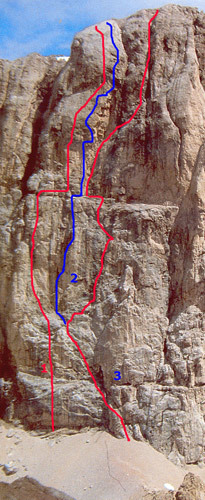
The southwest face of the Marmolada di Penia (3343m), Italian Dolomites, showing (1) La Larcher-Vigiani (8a, 7b obl., 550m, Larcher-Vigiani, 2000, FFA Larcher-Vigiani, 2001). (2) AlexAnna (Not yet redpointed but estimated to be 8a+/8b, 550m, 17 pitches, Larcher and various partners, 2007 and 2008), (3) Solda Route (VII, 550m, Conforto-Solda, 1936). [Photo] Claudio Cima
AlexAnna is the new offering from Italian Rolando Larcher on the great southern walls of the Marmolada, one of the most iconic of the Dolomites. The seventeen-pitch route, which is still awaiting a redpoint ascent, lies toward the left side of this vast limestone wall, climbing the shorter southwest face of the 3343m Marmolada di Penia. Larcher spent six days working the route with various partners, four days in 2007 and two this summer.
Larcher employed his usual style, climbing from the ground up, using natural protection where possible and only resorting to bolts–as always, drilled by hand–when faced with totally compact rock. In the end he placed eleven protection bolts (plus two per belay stance). His principal difficulty this summer was the unseasonably poor weather, which made it quite cold at 3000m, not only for himself on lead, but also for his patient belayers. In the end he was able to climb the first half or so of the line, onsight, up to 7a+ (5.11d) but in the upper section, where the main technical difficulties are to be found, had to resort to rest points. He managed to free each individual move and reckons the eventual redpoint, which is now unlikely to occur before 2009, will be 8a+/8b (5.13c/d) with obligatory sequences of 7b (5.12b).
AlexAnna, named after Larcher’s children, takes an exposed line left of the classic Solda Route (VII [5.10d], 550m, Conforto-Solda, 1936: one of the hardest pre-war routes in the Dolomites). But it isn’t his first route on this sector of the face. In 2000, with Roberto Vigiani, he climbed the right edge of the Cristina Pillar, a prominent feature that leads to the compact and overhanging Lindo Pillar immediately left of the Solda. The pair returned in August 2001 and in a 12-hour day made the first redpoint ascent of what they dubbed La Larcher-Vigiani. The quality of the route was outstanding, the rock rough and pocketed but offering very little in the way of natural protection.
Forcing a bold line through the center of the Lindo Pillar, the Larcher-Vigiani has thirteen pitches out of which only the first two and the seventh, which has a boulder problem crux of 7a, and an easy scrambling pitch to finish, are less than 7b. The eighth pitch is 8a (5.13b). The ninth pitch (7b+) was, according to Larcher at the time, the best pitch he had ever climbed. Ninety bolts were placed, so only quickdraws are necessary, but the spaced nature of Larcher placements means that obligatory difficulties are high (7b). The route had to wait until 2005 for a repeat, when Bruno Pederiva and Mario Prinoth climbed it after a number of previous attempts.
Larcher chose this sector of the Marmolada because there is still plenty of potential for new lines that will not interfere with existing routes. Although this certainly wasn’t the first route to use bolts on the Marmolada, it is an almost exclusively bolt-protected route, and at the time some Italians, who still consider the South Face of the Marmolada to be hallowed ground, were a little critical of the drilling. Others felt it the forerunner of the next stage in Marmolada development.
The initial section of the southwest face is an almost unbroken line of overhangs, and there are few possibilities for completely free entries. AlexAnna uses the first three pitches of the Solda and then branches left to climb a steep corner system right of the Larcher-Vigiani, before finishing up the right side of the Lindo Pillar in a superb position.